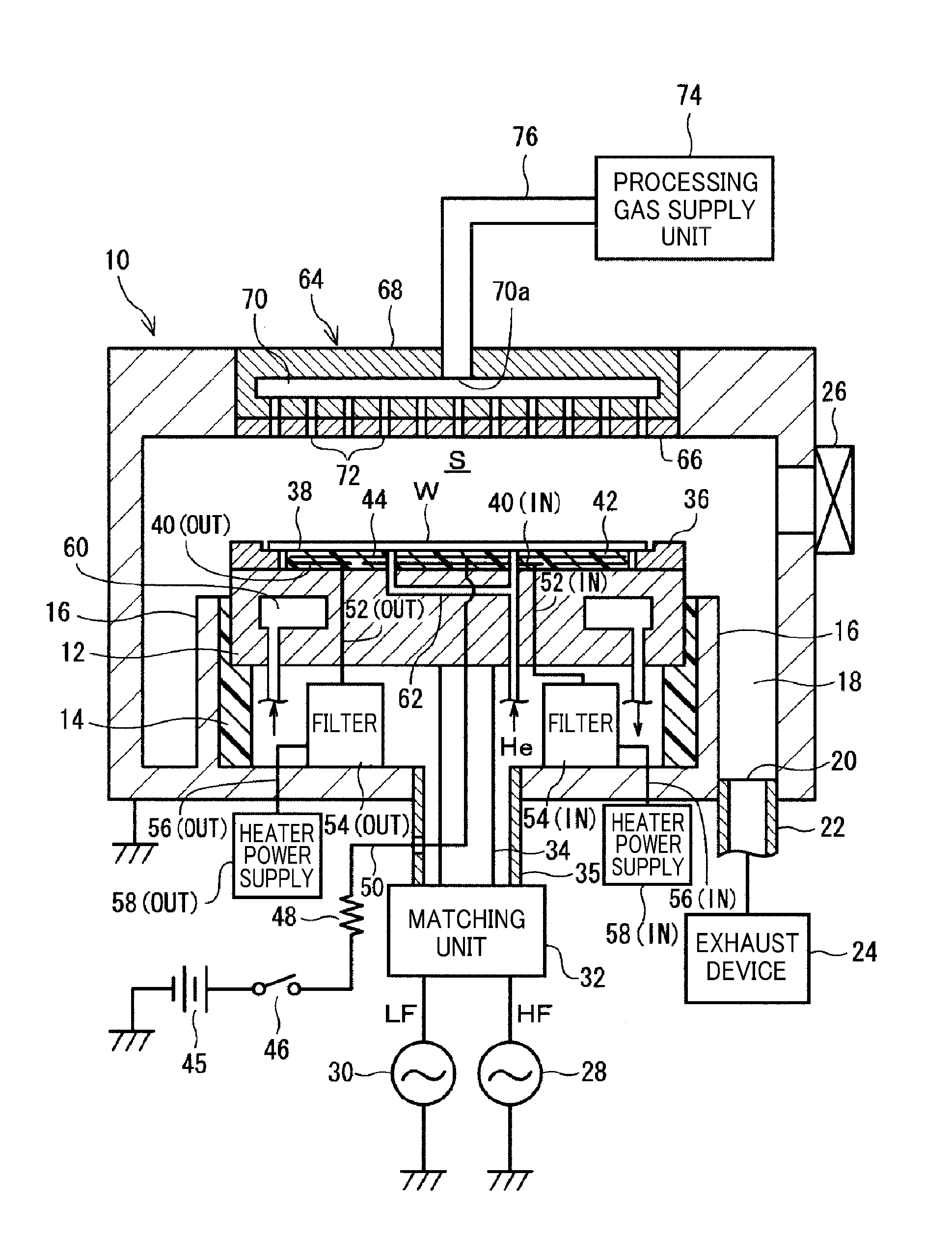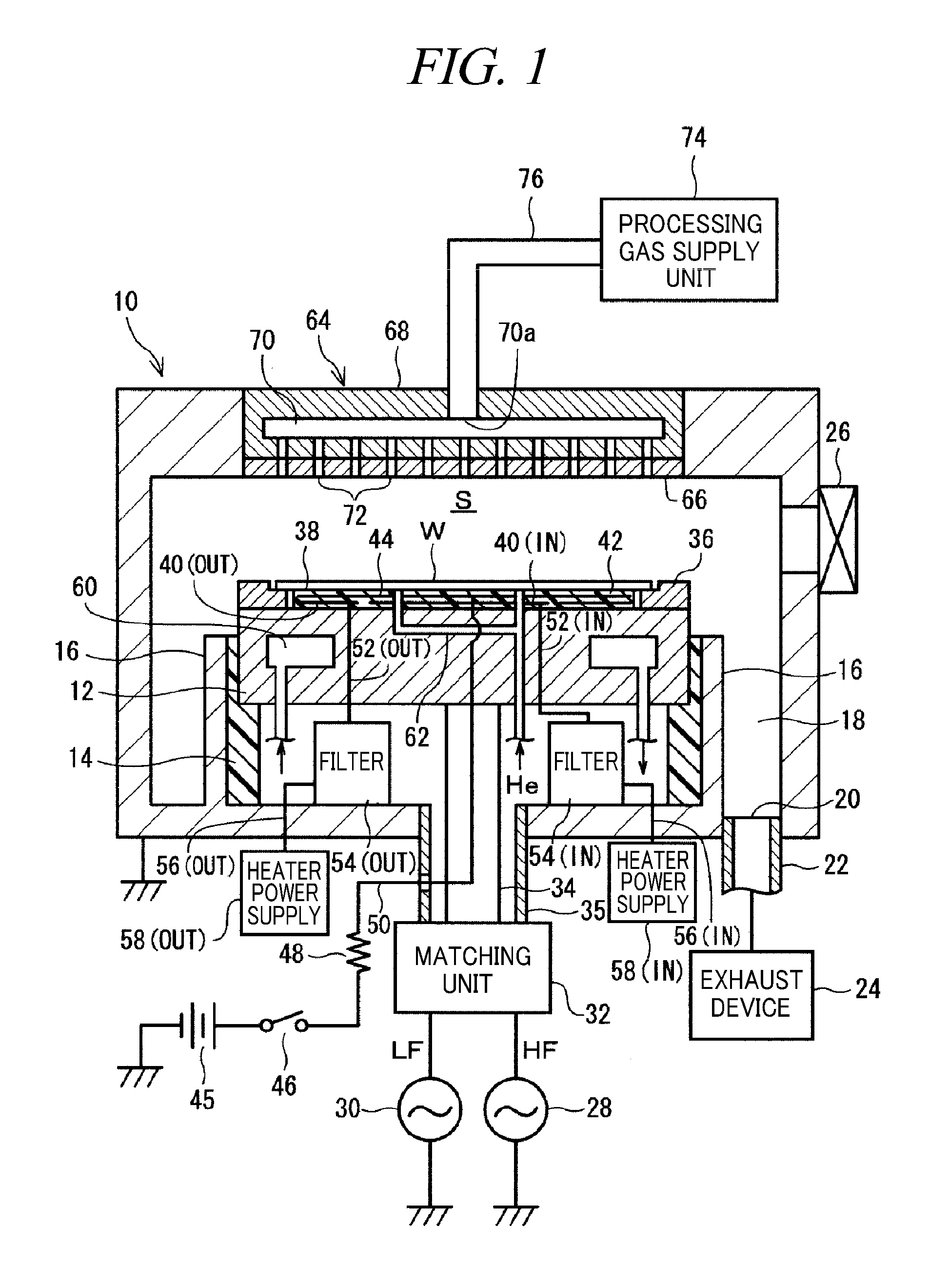Plasma processing apparatus
a processing apparatus and plasma technology, applied in the field of plasma processing apparatus, can solve the problems of difficult rapid change of coolant temperature, low temperature control responsiveness, deterioration of semiconductor device or display device production yield, etc., to improve reliability and improve the impedance for high frequency noise, and improve the reproducibility of plasma process.
- Summary
- Abstract
- Description
- Claims
- Application Information
AI Technical Summary
Benefits of technology
Problems solved by technology
Method used
Image
Examples
first experimental example
[First Experimental Example of Filter]
[0085]FIGS. 4 to 7 illustrate a physical structure of a filter unit 54(IN) in accordance with a first experimental example. In the filter unit 54(IN), as shown in FIGS. 4 and 5, a coil 104(1) of a first filter 102(1) and a coil 104(2) of a second filter 102(2) are coaxially provided within a cylindrical outer conductor 110 made of, e.g., aluminum. Further, on an opposite side of filter terminals T(1) and T(2), a capacitor 106(1) of the first filter 102(1) and a capacitor 106(2) of the second filter 102(2) are accommodated together within a capacitor box 112 made of, e.g., aluminum, as shown in FIG. 2. The outer conductor 110 is fixed to a conductive member of a ground potential, e.g., a chamber 10 by screws.
[0086]Each of the coils 104(1) and 104(2) may be an air core coil and has a function as a power feed line through which a sufficiently high current (e.g., about 30 A) flows from a heater power supply 58(IN) into an inner heating wire 40(IN). ...
second experimental example
[Second Experimental Example of Filter]
[0122]FIG. 15 illustrates a physical structure of a filter unit 54(IN) in accordance with a second experimental example. An inventive feature of the second experimental example lies in that a parallel resonance frequency controller for adjusting a parallel resonance frequency is further included in a filter unit 54(IN) as used in the first experimental example. In the following second experimental example, a configuration of a first filter 102(1) and an operation of a first distributed constant line 120(1) will be described. A configuration of the second filter 102(2) and an operation of a second distributed constant line 120(2) are completely the same as those of the first filter 102(1) and the first distributed constant line 120(1).
[0123]The parallel resonance frequency controller may be configured as a characteristic impedance varying member for partially varying a characteristic impedance of a distributed constant line 120(1) by causing a p...
third experimental example
[Third Experimental Example of Filter]
[0137]FIG. 17 illustrates a physical structure of a filter unit 54(IN) in accordance with a third experimental example. The third experimental example is a modification example of the above-described second experimental example, and one filter 102(1) includes a plurality of, e.g., two ring members 122. Although the plurality of ring members 122 and 122 may have different shapes, sizes and materials, it may be typically desirable that they have the same shape, size and material.
[0138]The present inventors fabricated the sample filter unit 54(IN) having the aforementioned configuration in accordance with the third experimental example shown in FIG. 17, and an impedance characteristic is measured using a network analyzer as described above, and then the impedance characteristic of the sample product in accordance with third experimental example is compared with that of the sample product in each of the first and second experimental examples.
[0139]F...
PUM
 Login to View More
Login to View More Abstract
Description
Claims
Application Information
 Login to View More
Login to View More - R&D
- Intellectual Property
- Life Sciences
- Materials
- Tech Scout
- Unparalleled Data Quality
- Higher Quality Content
- 60% Fewer Hallucinations
Browse by: Latest US Patents, China's latest patents, Technical Efficacy Thesaurus, Application Domain, Technology Topic, Popular Technical Reports.
© 2025 PatSnap. All rights reserved.Legal|Privacy policy|Modern Slavery Act Transparency Statement|Sitemap|About US| Contact US: help@patsnap.com



